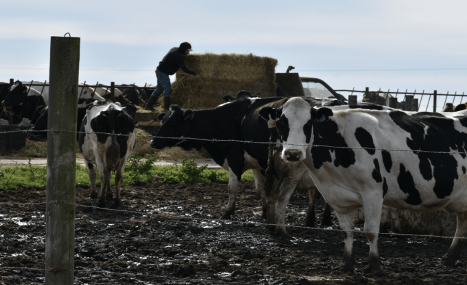CommentsREVENGER-IN-CHIEF-During its planning process for Point Reyes National Seashore, the National Park Service received overwhelming public input opposing commercial ranching on and supporting the recovery of the rare tule elk. (photo above)
The Trump administration, after sparring with the California state government on climate issues, has now unveiled a proposed plan that would expand ranch operations, and further harm elk recovery on these Park Service lands. It’s shaping up to be an anti-environmental decision that advances extractive industries and undermines efforts to maximize carbon sequestration on public lands.
Wildlife should always have the freedom to roam throughout their native habitats, particularly on Park Service lands. On Point Reyes, they can’t. The majority of elk on Point Reyes National Seashore are trapped behind an eight-foot-tall fence on Tomales Point, a narrow peninsula that lacks fresh water during the increasingly severe droughts that California has been experiencing. Between 2012 and 2014, more than 250 elk – half of the Tomales Point herd – died of thirst, trapped behind the wire and denied access streams and ponds that they would have used prior to the relatively recent advent of commercial ranching and dairy operations on this part of the California coast.
Now it’s happening again, with 15 dead elk reported so far during this summer’s dry spell. Concerned members of the public have defied fire closures and hauled in fresh water to save the elk from death by thirst. The Park Service has destroyed these water sources.
It is scandalous that Point Reyes’ most famous species of native wildlife is denied the right to roam freely across its native habitat, and equally scandalous that the Park Service is putting the profit motive of a handful of private ranchers – who shouldn’t be there in the first place – over the native wildlife that the agency has a legal obligation to preserve.
The Park Service’s Tule Elk Management Plan, finalized in 1998, committed to a free-ranging elk population by 2005. A smaller population of the elk was transplanted to wilderness lands in the Limantour area, with some splitting off and establishing a small herd near Drake’s Beach. On lands leased for livestock production, however, elk have been hazed, harassed, and even killed by the Park Service or ranchers. And the fence confining the largest herd of tule elk to Tomales Point remains.

Cattle operation at Point Reyes.
In October of last year, President Trump held a bill-signing ceremony and invited Kevin Lunny, the ringleader of the anti-environmental ranchers on Point Reyes, to speak. In response, Trump said, “No American should face such persecution from their government,” and now has made good by delivering a proposed plan for Point Reyes that locks in ranching for the long haul and authorizes continued confinement, harassment, and even killing of the native wildlife on Park Service lands for the benefit of the ranchers.
When the Park Service sought public input on its National Seashore plan, the results were overwhelming. Some 91.4% of public comments opposed ranching on Point Reyes National Seashore, while only 2.3% supported extending it. Of those comments that endorsed a particular plan alternative, 94% supported the alternative phasing out cattle ranching and dairy operations completely on the National Seashore. Who is representing these Californians in Congress, and why aren’t we seeing Congressional direction to protect the rare tule elk before an Endangered Species Act listing is needed?
Confinement during drought isn’t the only reason livestock are bad for tule elk. Cattle are known be carriers of Johne’s disease, a zoonotic disease that infects elk and also can be transmitted to humans, causing Krohne’s disease, colon cancer, and other maladies. Conservationists put the Park Service on notice on the science regarding the serious public health risk posed by this cattle-borne disease. The agency’s analysis of Johne’s disease fails to acknowledge that cattle are the primary carriers, focusing instead on how the disease affects elk, and completely ignores the risk this livestock disease poses to the recreating public on the National Seashore.
And cattle cause problems for other parts of the seashore as well. Already, heavy overgrazing by cattle has converted the native coastal grasslands into weed patches of invasive European weeds. Most of these weeds are annuals, dying and giving up their carbon. Restoring the native perennial grasses to Point Reyes would help that landscape sequester more carbon in the soil, helping solve, rather than exacerbate, the climate crisis.
Despite the overwhelming public repudiation of the commercial livestock industry, the Park Service proposes to re-authorize those same operations, and even expand them to allow a variety of other commercial uses of leased Park Service lands. It would keep the Tomales Point elk fence in place, extending the confinement of the Seashore’s largest tule elk herd, and frustrate the ability of elk to recover on other lands outside the fence. It even proposes “lethal removal operations” targeting tule elk for the benefit of livestock operations.
Trump’s plan for Point Reyes is the ultimate expression of putting commercial exploitation of public lands in the driver’s seat, at the expense of healthy lands and native wildlife. The National Park Service’s mission is to protect and preserve lands and wildlife for the use and enjoyment of the people. In its proposed plan for Point Reyes, the agency clearly and obviously is not doing its job.
(Erik Molvar is a wildlife biologist and is the Laramie, Wyoming-based Executive Director of Western Watersheds Project, a nonprofit group dedicated to protecting and restoring watersheds and wildlife on western public lands. This piece appeared on CounterPunch.org.) Photos by Erik Molvar. Prepped for CityWatch by Linda Abrams.

















